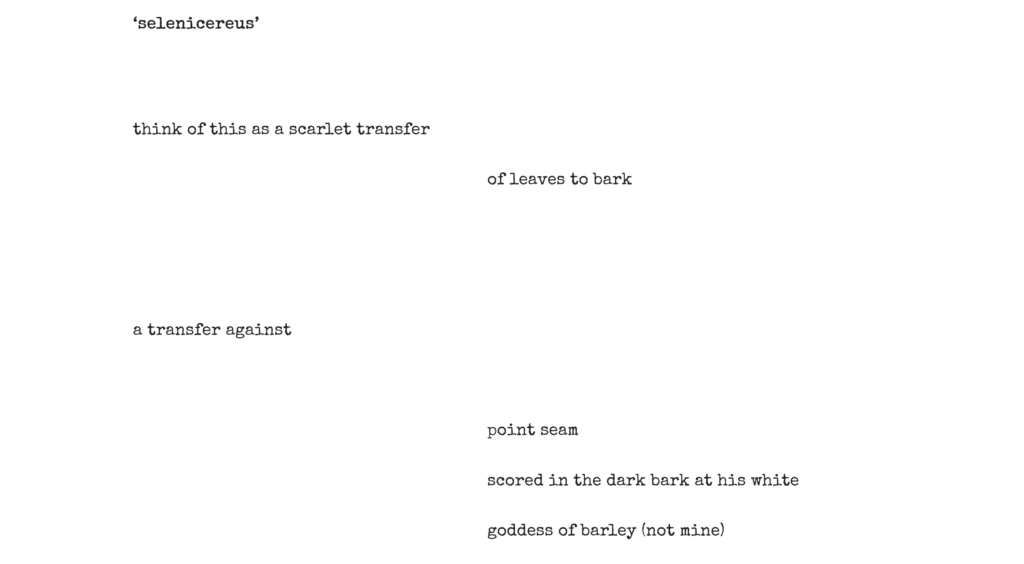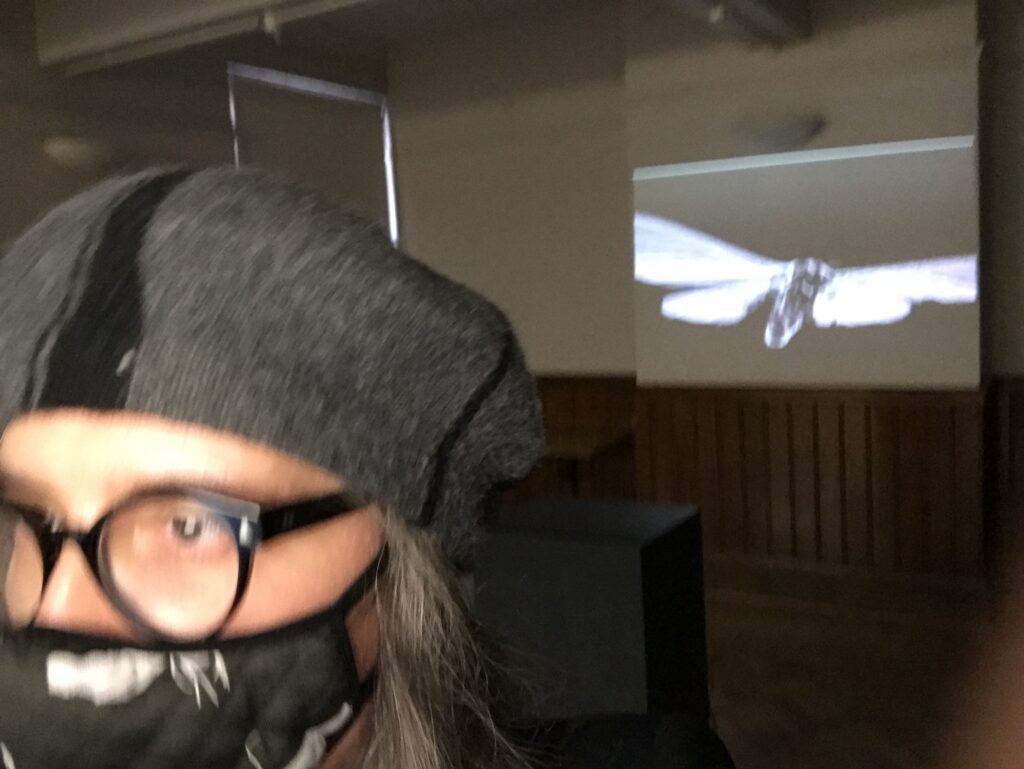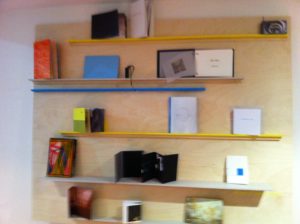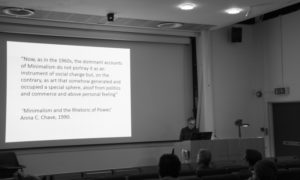poem essay in The Ethnobotanical Assembly (TEA)


https://www.tea-assembly.com/issues/8/moonflower-2021-or-a-scarlet-transfer
Details of the full issue and introduction from Felix Driver and Caroline Cornish below:




https://www.tea-assembly.com/issues/8/moonflower-2021-or-a-scarlet-transfer
Details of the full issue and introduction from Felix Driver and Caroline Cornish below:

3 November – 7 November 2021
10:00 – 17:00
Talk on Saturday at 2 pm (booking required)

Fragments From an Interspecies Opera: Acis and Galatea Rewilded,
or, a Serenata; or Pastoral Entertainment in the Age of Extinction
The moths that appear in this film were gifted by the renowned entomologist Dr Roger Key to Will Evans who is a current PhD researcher on the BioDar project at The University of Leeds. The moths were contained in four boxes acquired by Key nearly twenty years ago when the Leeds City Museum restructured its collections. Although the moths were in an undamaged condition, they did not have enough data attached to them to warrant keeping. Dr. Key’s own collection, that he made as a child, was donated to Scunthorpe Museum during the 1970s. When Dr. Key visited the museum there he found that his boyhood collection had been reduced to powder by museum beetles, booklice, clothes moths and mites. Will Evans was taught his insect identification skills by Dr. Key.
Will Evans collaborated with Redell Olsen in the making of this film by scanning the moths on the project’s newly acquired Artec 3D scanner. Filming took place under lockdown. Evans set up the insects in the lab and they were then filmed by Olsen through a digital online platform as Olsen directed Evans to move the view of the insects by moving the cursor on his screen. That the cursor remains visible in the final film offers a trace of the process and production involved, a Brechtian reminder of agency and control rather than a Hollywoodization and reification of insects long dead.
The audio that accompanies the film reimagines George Frideric Handel’s pastoral opera, Acis and Galatea with the new lyrics of an imagined inter-species opera, extracts of which are performed in collaboration with the Chorus of Opera North and bass-baritone Matthew Stiff, as a response to the current climate crisis and environmental degradation.
The new text of Handel’s air to be sung to the music of Acis and Galatea – O Ruddier Than The Cherry holds particular contemporary relevance in relation to the meetings by international leaders at Cop26 in November 2021.
Opera North
Oliver Rundell and the Chorus at Opera North:
Sarah Blood, Sarah Estill, Rachel J Mosley, Victoria Sharp, Anna Barry, Cordelia Fish, Katie Walker, Warren Gillespie, David Llewellyn, Arwel Price, Graham Russell, Ivan Sharpe, Paul Gibson, Ross McInroy, Richard Mosley-Evans, Jeremy Peaker, Gordon Shaw with Martin Pickard – piano ‘radar watchers’.
Matthew Stiff – ‘bass-baritone’, David Cowan – piano
24 June 2020
WINNER OF DARE ART PRIZE 2020-21 ANNOUNCED BY OPERA NORTH AND THE UNIVERSITY OF LEEDS
The poet, writer and visual artist Redell Olsen has been announced as the winner of the DARE Art Prize 2020-21 by the University of Leeds and Opera North, in association with the National Science and Media Museum and The Tetley, Leeds.
Redell’s proposal includes the creation of a new song cycle and film, using scientific data measuring different species of insects in our skies. This will be both an artwork and a contribution to the research of the University of Leeds’ BioDAR unit, by exploring alternative ways to represent climate change and the risk of species extinction.
Information about insects and other animals in the sky is a by-product of the UK’s extensive weather radar network. Previously discarded by weather scientists, it is hugely valuable in the mapping of insect life. The BioDAR Team is developing ways to recognise and measure different species of insects in the skies using this data, employing 3D modelling and academic expertise from the fields of biology, ecology, physics and atmospheric science. Redell Olsen’s DARE Art Project proposal will bring another, less expected discipline – the arts – to the programme.
Challenging artists and scientists to collaborate on new approaches to the creative process, the Prize is part of the innovative DARE partnership between the University and the national opera company, also based in Leeds. It offers an artist the opportunity to produce new work in partnership with leading scientific researchers at the University of Leeds, and staff and performers from Opera North. Residencies at The Tetley, Leeds’ centre for contemporary art, and collaborations and showcases with the National Science and Media Museum, Bradford, are also available.
A British poet and writer who often works with film and performance, Redell lectures at Royal Holloway, University of London, where her research and teaching specialisms include innovative poetics, conceptual writing, bookarts and sound.
“How might a poet/artist contribute to the interpretation of scientific data, or even propose the work of art as another potential recording device alongside scientific instruments?”, she asks in her proposal.
During the course of the year she will be developing her project in ways that both acknowledge the constraints of our current situation and find ways around them. Alongside her own writing, she will be exploring various modes of artistic practice and audience engagement across a wide range of media and collaborative practice. She has already begun work on the commission under lockdown, meeting the BioDAR team virtually and exploring collaborations with Opera North’s music staff and ensembles.
Redell Olsen comments:
“I am so pleased to be awarded the DARE Art Prize 2020-21. I don’t think there is anything else quite like it! I am so looking forward to developing a new piece of work in collaboration with the research of the BioDAR team at the University of Leeds and with the amazing Opera North. I am really excited at the opportunity to work with The Tetley Art Gallery and to be able to draw on the expertise of the National Science and Media Museum. What a great team to be in dialogue with! More than ever we need the possibility of such collaborative exchanges between art and science!”
Dr Christopher Hassall, Associate Professor of Animal Biology, University of Leeds, and leader of the BioDAR project, comments:
“We are delighted to have an artist collaborating with the BioDAR project. The research project is already interdisciplinary, combining the unique and complementary contributions of atmospheric scientists, ecologists, and data scientists.
“However, a major challenge for us is how to present complex information in a way that is engaging and informative for technical and general audiences. Redell’s perspective on the work will not only add a novel way for us to communicate the project outputs but will also challenge us to think about how we work together as a wider interdisciplinary team.”
This year’s DARE Art Prize received a record number of entries from across the globe. The six shortlisted artists presented compelling proposals for understanding and embodying scientific issues through a wide range of media.
Friday 3 November 2017, 7pm-9pm
The Parasol Unit Foundation for Contemporary Art, 14 Wharf Road, London, N1 7RW
Redell Olsen in conversation with Carolyn Pedwell
S A L O N – LONDON, a site for reading and responding to the present through women’s experimental writing, is pleased to announce its launch event, featuring Redell Olsen, who will be reading from two recent works, ‘Woolf / Apelles’ and ‘Atomic Guildswomen’, followed by conversation with Carolyn Pedwell.
Redell Olsen’s poetic practice comprises poetry as well as texts for performance, film and installation. Her publications include Film Poems (Les Figues, 2014), ‘Punk Faun: a bar rock pastel’ (Subpress, 2012), ‘Secure Portable Space’ (Reality Street, 2004), ‘Book of the Fur’ (rem press 2000), and, in collaboration with the bookartist Susan Johanknecht, ‘Here Are My Instructions’ (Gefn, 2004). Her work is included in Infinite Difference: Other Poetries by UK Women Poets (Shearsman, 2010), I’ll Drown My Book: ‘Conceptual Writing
by Women’ (Les Figues Press, 2011) and Out of Everywhere 2: Linguistically Innovative Poetry by Women in North America & the UK (Reality Street Press, 2016). In 2017 she published two bookworks Smock and Mox Nox. She has also published a number of critical articles on contemporary poetry and the relationship between contemporary poetics and the visual arts. In 2002 she set up the influential MA in Poetic Practice at Royal Holloway which she still runs as part of the MA in Creative Writing. From 2006 – 2010 she was the editor of How2, the international online journal for Modernist and contemporary writing by women. In 2013-14 she was the visiting Judith E. Wilson fellow at the University of Cambridge. In 2016-17, in association with other members of staff from English and Modern Languages at Royal Holloway, she led the HARC funded project ‘Nature and Other Forms of That Matter’. She is Director of the Poetics Research Centre at Royal Holloway. redellolsen.co.uk
Carolyn Pedwell is Associate Professor in Cultural Studies at the University of Kent, where she is Head of Cultural Studies and Media. Carolyn has been Visiting Fellow at the Department of Gender and Cultural Studies, University of Sydney; the Centre for the History of Emotions, Queen Mary University of London; and the Gender Institute, London School of Economics. She is the author of Affective Relations: The Transnational Politics of Empathy (Palgrave, 2014) and Feminism, Culture and Embodied Practice (Routledge, 2010). Her new book, Transforming Habit: Revolution, Routine and Social Change, is under contract with McGill-Queen’s University Press. Carolyn is also an Editor of Feminist Theory journal.
S A L O N – LONDON is organized by Georgina Colby and Susan Rudy. The launch of S A L O N – LONDON has been funded by the Institute of Modern and Contemporary Culture at the University of Westminster, the Centre for Poetry, Queen Mary University of London, and the School of English and Drama, Queen Mary University of London.
Please register here: Eventbrite
ANATHEMA is a new reading series for experimental poetry and writing in Bristol, curated by Moot Press + Hesterglock Press + Sad Press
 The Light Room
The Light Room
Arnolfini, 16 Narrow Quay, Bristol
BS1 4QA
Friday 31st March
6.30pm
Free (donation)
Poetry Reading in Bristol at the Arnolfini – More details here.
 ‘mox nox’ exhibited in BOOKMARE: project 2 of average sunlight
‘mox nox’ exhibited in BOOKMARE: project 2 of average sunlight
Exhibition until May 2017
Millimetre02
Kingsgate Project Space 110-116 Kingsgate Road London NW6 2JG
Opening Event: 6-9 pm March 2nd
millimetreprojects.com
 Keynote performance lecture – Professor Redell Olsen
Keynote performance lecture – Professor Redell Olsen
I See/You Mean: The Minimalist Roman[ce]
Taking as its starting point the post-Minimalist nouveau roman, ‘I See/You Mean’ by Lucy Lippard this lecture will explore Minimalism in the visual arts and writing. It will consider aspects of critical discourse on Minimalism as itself encoding forms of romance and propose a counter series of poetic interventions by way of response.
Redell Olsen is a poet and text based artist whose visual work involves live performance with stills or moving image. Film Poems (Les Figues, 2014) collects the texts for her films and performances from 2007–2012. Her previous books include: ‘Punk Faun: a bar rock pastel’ (Subpress, 2012), ‘Secure Portable Space’ (Reality Street, 2004), ‘Book of the Fur’ (rem press 2000), and, in collaboration with the bookartist Susan Johanknecht, ‘Here Are My Instructions’ (Gefn, 2004). From 2006-2010 she was the editor of How2, the international online journal for Modernist and contemporary writing by women. In 2013-14 she was the Judith E. Wilson visiting fellow in poetry at the University of Cambridge. She is currently Professor of Poetry and Poetics at Royal Holloway, University of London. redellolsen.co.uk
28 April 2016, 14.15 till 15.00 — Royal Academy of Art
In 1967 Art and Language designated a column of air ‘art.’ The place of writing as and in place of painting seemed assured. When you begin to look away from seeing and reading the dematerialised art work, there emerges a new possibility, a poetics of flickers. In 2016 this column of written air flickers with art forms very different from the art critical language associated with conceptual art. What does this flickering reveal? Poetics and the visual arts flicker with glimpses of this not not-conceptual-art, and not not-writing-as art. My performance/lecture will explore how writing might engage with a flickering ekphrastic turn to landscape painting and its spin-offs. Timothy Morton questions whether ‘Nature’ was ever really there as more than a flickering ghost. I will nevertheless resist the double bind associated with simplistic definitions of ekphrasis, undoing the binary logic of writing as a half-glimpsed phantom of another ‘proper’ subject. The possibility of the filmic will be registered across the boundaries between the documentary, the poetic, and the visual-as-writing. Tracing this exploration through existing works and images, this lecture/performance hopes to enact a writing of paintings for paintings and an aesthetics of art that flickers in writing.
http://www.sarconference2016.net/rc/index.html#archive
Video of Paper here